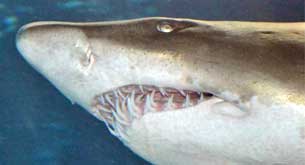Facts about Sharks
Posted by Admin / in Science Facts

Sharks are one of the most feared hunters of all the animals.
Interesting Facts about Sharks
- Sharks are classified as vertebrates, meaning they have a backbone. A shark's backbone is not really made out of bone it is cartilage.
- Scientists consider sharks fish.
- Sharks are grouped under the category of fish called cartilaginous fish. Other cartilaginous fish include rays and skates, which are similar to sharks.
- Scientists have discovered more than 350 species of sharks.
- Generally sharks are carnivorous (sharks eat other animals).
- Shark babies are called pups.
- Sharks generally live in saltwater, however, some sharks like the bull shark can live in freshwater rivers near the ocean.
- Sharks breathe with their gills, similar to fish. As sharks move through the water, the water passes over their gills. Oxygen is transferred from the water to the shark's blood by their gills. Sharks have at least 5 gills, although some sharks have 6 or 7 gills.
- The skin of a shark contains tiny teeth called denticles. Denticles are made of dentine and enamel, like our own teeth.
- Sharks have eyelids. Fish do not have eyelids.
- Sharks do not have swim bladders like fish. Swim bladders help fish keep their position in the water. This is why fish can swim in one spot and not sink. Sharks must keep swimming all the time to avoid sinking to the bottom.
- Sharks have teeth that constantly re-grow during their life.
- Most sharks also have powerful jaws. Some sharks, like the great white shark, can bite through metal.
- When sharks eat, they swallow their prey whole. They use their teeth only to bite and hold onto their prey. The only exception, that scientist know of is the cookie-cutter shark. This type of shark is small and takes a round, cookie-shaped, bit out of its prey.
- Basking sharks and whale sharks, which are the two largest shark species, open their mouths and feed on tiny fish, similar to baleen whales.
- Sharks have excellent hearing. Some sharks can use their sense of hearing to detect other animals in the water up to 3000 feet (914 meters) away.
- Sharks also have an excellent sense of smell. Scientists who have studied the shark's brain have determined that the part of their brain that processing the shark's hearing is one-third of their overall brain size.
- Sharks also have a line of sensors on their sides. These sensors help them detect movement in the water around them.
- Whale sharks are the largest sharks. They grow to a length of 40 to 45 feet (12 to 14 meters) long and weigh up to 13 tons (12 metric tons).
Our Shark Facts Video
